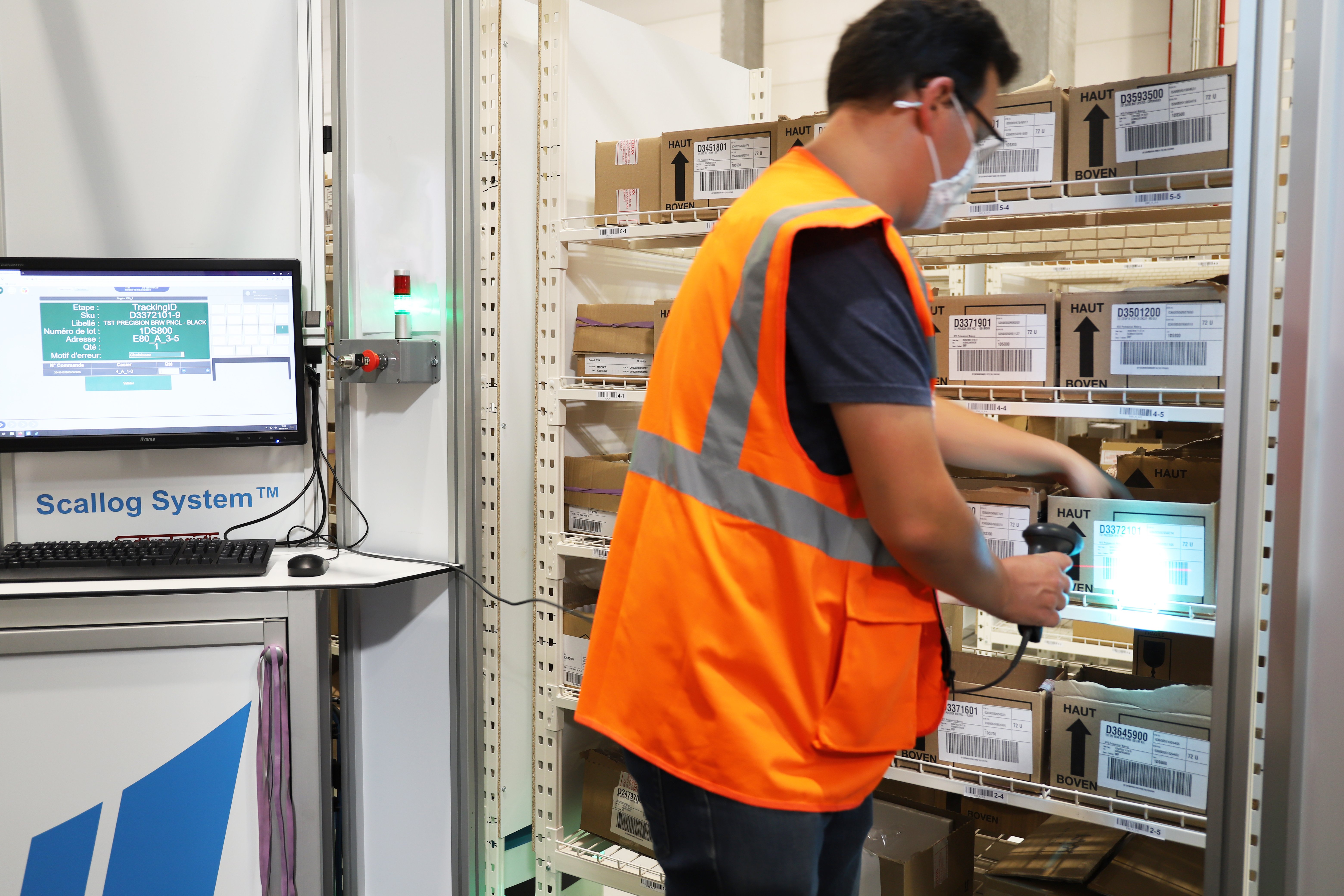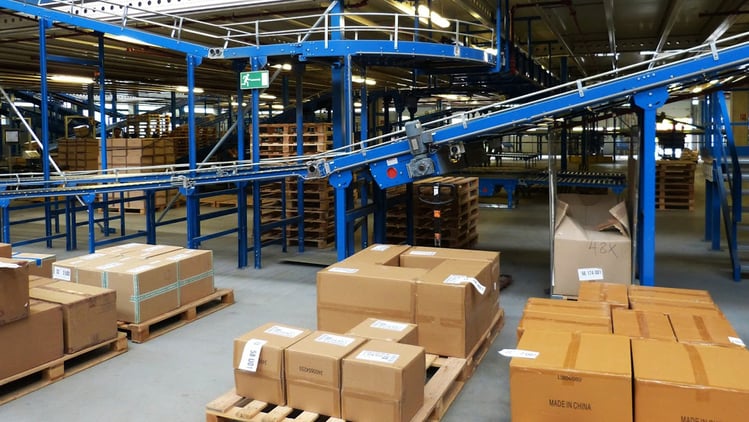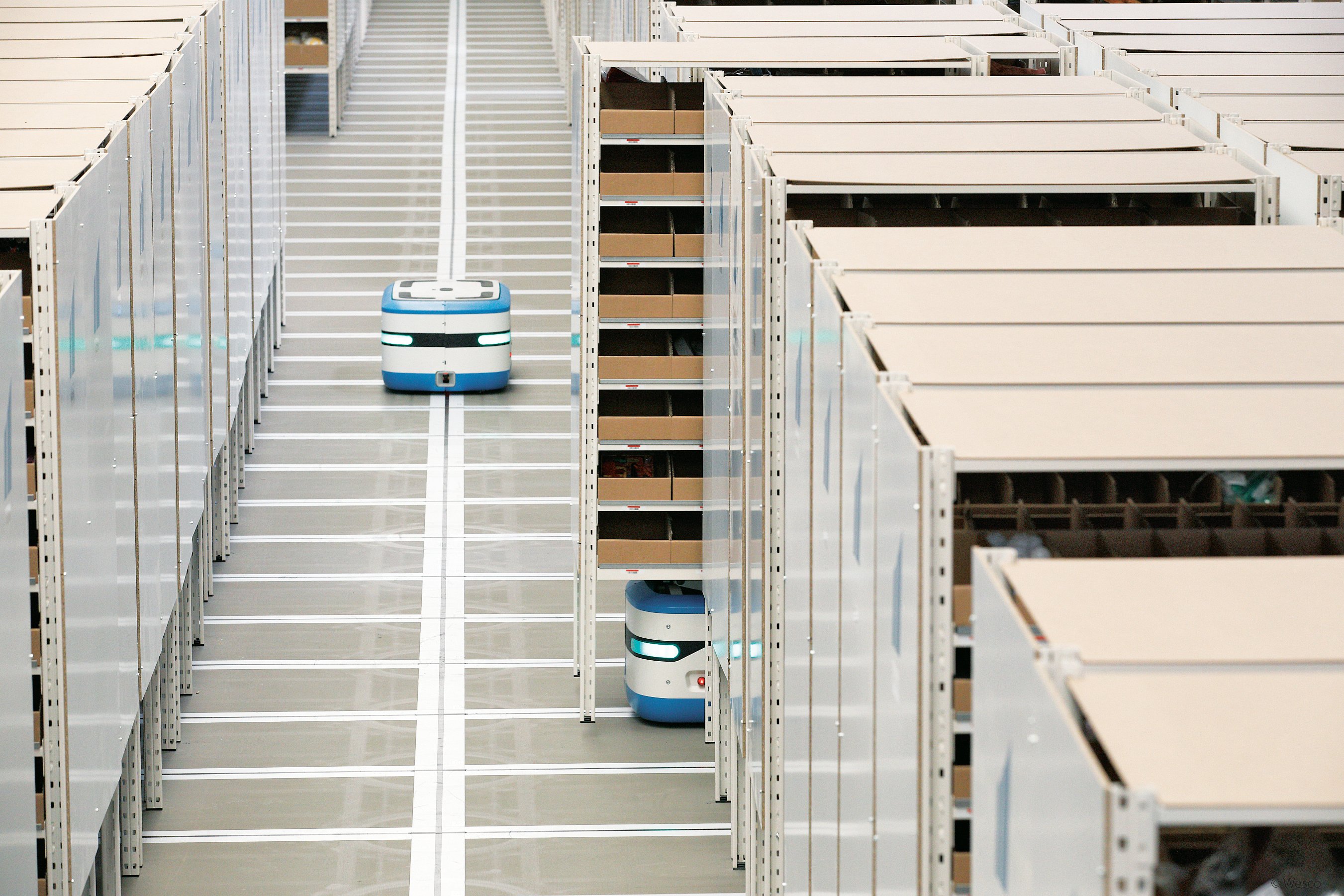In order fulfilment, we make a distinction between wholesale picking and retail picking.
Wholesale picking deals with large quantities, generally destined for re-stocking retail outlets.
In wholesale picking we never take a single article - we take boxes or whole pallets of products.
In retail picking, only a few products with certain characteristics (size, colour etc.) are picked.
Retail picking is increasingly used in the rapidly-expanding e-commerce sector
This type of order picking uses sophisticated methods and technologies that combine high-volume processing capacity with minimum cost and the assurance of very high quality of fulfilment.
Picking is traditionally done manually, but advances in technology are opening new prospects. When it comes to retail picking, numerous automation solutions have emerged. So how do we choose the best solution ? Which solutions are the most interesting? How are they used? And what are their benefits? Read on for the answers.
Automation in the service of the warehouse
Man to goods or goods to man: Which robots do I need for my distribution centre?
Depending on the type of picking they do, warehouses may opt for:

Mobile robots dedicated to man to goods picking
In this model, the person goes to the product. The robot acts as a picking trolley and serves the human operator in complete autonomy.The operator is responsible only for selecting products from the shelves and depositing them in the robot.
To avoid unnecessary movement by the operator, the robot carries the deposited products to the consolidation and packaging zones.
Mobile robots dedicated to goods to man picking
In this model, the product goes to the person. The robot can lift an entire shelf unit containing the desired article (usually small or medium sized).
The mobile robot then brings the shelf unit to an order picking station. Without having to move from his station, the operator receives the shelf units in a sequence favourable to the organization of orders.
Once the process is complete, the robot returns the shelving to its original place and starts on its next task.
The goods to man model is recommended for fulfilling many small orders (B2C) and boxes for store re-stocking (B2B). This system is ideal for medium- and low-turnover items.
Une fois le processus achevé, le robot remet le rayonnage à sa place initiale afin d’effectuer la tâche suivante.
For improved warehouse efficiency, goods to man picking requires the turnover rates of articles to be calculated.
How can turnover rates help determine the right automation solution?
According to the Pareto principle, 20% of products represent 80% of a company’s sales.
In a distribution centre using a goods to man system, the products most in demand will be stored on shelves close to the operator.
The aim is to make the product readily accessible to the operator as quickly as possible.
What is stock turnover?
In logistics, stock turnover is determined by the amount of time a product is stored before it's sold, on the one hand, and by its location on sales lines, on the other.
The most-ordered products are those with the highest turnover.
In the warehouse, these are the products that the operator must handle most often. These products general do not even have time to enter the stock because they are immediately sold, and so they are left on pallets where they can be picked as required.
Consequently, when grouped in one location, these items generate high product pick-up with very little movement.
Without using an automation system, a lot of picking can be performed on a floor space of just a few square metres.
Automating such a process would incur significant costs for negligible gains.
Automated systems are therefore more suitable for picking orders containing products with medium or low turnover.
Determining product turnover is easier in some sectors than in others.
Customers have their own consumption habits, and determining the turnover rate of a food product will be easier than that of e.g. a clothing product.
The reason for this is that fashion (“basics” excepted) is a constantly changing sector where trends follow in quick succession.
B2B sales to sector professionals are generally wholesale: the precise number of stores served and quantities of product delivered are defined in advance. These stores can then be restocked with retail order picking, as the stocks held by each store vary with sales.
Standing orders are usually constant, and with significant volumes. So everything can be planned in advance.
But online B2C sales, directed at individual consumers, are much more unpredictable.
Daily orders are numerous, but extremely heterogeneous, and for minimal quantities.
Scallog’s Deputy CEO Pierre Yves Minarro talks of “an average of 1.2 items per order in retail picking”.
Optimizing storage is therefore a key element in improving an enterprise’s logistics productivity.
When a distribution centre has to process orders placed by stores and by individuals over the Internet, it needs a productivity management system that’s efficient in every respect.
Technology then becomes its best ally. Automation is proving to be a major factor in performance.
La technologie devient alors son meilleur allié. L’automatisation s’affirme comme un facteur de performance considérable.

The different types of automation solution
Picking: from manual to automated
To process deliveries in manual picking mode, operators use carts.
These racks carry trays (each tray corresponding to an order) and navigate the storage area over a path determined in advance by a computer system (WMS or ERP).
They retrieve the requested items from the storage racks and take them to the packing zone where orders are boxed, sealed, and shipped.In this configuration, an operator walks 12 to 15 km per day, and can pick a maximum of 80 items per hour. This is a process that logistics professionals are constantly trying to accelerate.
In the 1950s, the automobile sector introduced automated guided vehicles (AGV).
Since then, the importance of AGVs in the logistics sector has grown steadily.
Pallet-moving AGVs using wire guidance technology were introduced in the 1990s.
This was followed in the early 2000s by the introduction of laser and geo-guidance technologies.
AGVs have evolved particularly rapidly in the last 20 years.
In 2005, new methods for optimizing storage emerged in the logistics sector.
The latest technology allowed any industrial handling cart to operate in automatic mode.
With robots that are increasingly intelligent, autonomous, collaborative and even equipped with greater load capacities, this technology is undergoing a new transformation.
Automated carts are able to perform more sophisticated handling actions than human operators in a safer, faster, and sometimes more accurate fashion.
Some carts have considerable great freedom of movement and can even pick orders - without following a standard route.
Latest-generation AGVs can handle loads other than pallets. from single items to shelves full of products.
One technology frequently used in wholesale order picking is the stacker crane.
Stacker cranes can store a very large number of pallets in a minimum of space.
Other automated systems such as station conveyors, tray systems, and mobile shelf units are increasingly used in the preparation of retail orders.
To optimize automation of a warehouse, decision makers first have to completely re-think their processes.
Disruption to existing logistics processes and the way operators are used to working is likely.
Station conveyors
Station conveyors eliminate the need to move around the warehouse, characteristic of the manual picking method. Station systems use a system of conveyors that carry orders between workstations or picking zones.
These zones generally handle different product lines or product categories. Only picking zones with operations pending are served.
Operators place the necessary items in the trays passing through their stock area. At their stations , they scan both the trays and the items they contain. Once the operation is complete, the operators push the package onto the removal conveyor.
The WCS or the programmable logic controller integrated into the conveyor system then distributes the orders to the various stations and the shipping zone.
This automation technology optimizes picking work and the movement of products. It’s especially suitable for orders containing several different items.
Thanks to the conveyor system, operators need only walk over a small portion of the storage surface.
DIn a manual handling system, personnel have to walk 12 km or more during a shift. When conveyors are used, the products are brought to the operators, who then only need to travel about 6 km.
Conveyors offer several benefits:
- Increased productivity, as pickers now operate in a smaller picking zone.
- Considerable time savings, as trays (or boxes) are automatically conveyed over most of their trajectory.
- Significant reductions in order errors.
But automation also has its disadvantages:
- Requires a maintenance contract providing rapid troubleshooting if necessary
- System is not very flexible
- Installation takes up a lot of floor space
However, there are other goods to man systems that literally take the product to the operator.
These can optimize storage and productivity by eliminating time-consuming operator movements.
Bin systems
Solutions in the tray system category include:
- Shuttle systems
- Mini-load
These two solutions operate on similar principles, but with different technologies.
The shuttle system
This system uses shuttles to put goods in storage.
To increase the work rate, horizontal and vertical movements use separate mechanisms. Vertical movements are performed by an elevator.
Most systems have an independent shuttle at each level. The shuttles move horizontally. Although a transfer of load between the two drive systems is necessary, the number of cycles per aisle is approximately five times greater than with a “mini-load” solution.
The shuttle takes the place of a trolley. Items can be grouped by channel (as opposed to grouping by full aisles), which helps reduce processing time. The operator manages the shuttles remotely, using a tablet connected to the Wi-Fi network.
What makes this solution different from the others its multitasking capabilities. The more shuttles used, the quicker the goods get to the operator. This solution reduces handling costs and improves supply chain processes.
In the faster shuttle systems, workstations have conveyors at the front allowing the trays to be placed on them.
To prevent musculoskeletal disorders in operators, stations have right-hand and left-hand outlets, with the orders trays in the facing position.
The mini-load system
Automated order picking is more and more frequent in logistics, as it saves time and improves efficiency - which means productivity gains.
Framed in these terms, the mini-load solution is designed to accelerate the picking and automatic storage of loads which are simultaneously light and small.
This mini-load solution consists of a rack with a moving stacker crane that moves along the racks to shift and stow the trays containing products.
Other system components:
- a pallet stacker crane
- conveyors
- management software coupled to the warehouse’s WMS
The mini-load system is designed for use in warehouses formed by one or more aisles.
The racking lining the aisles is criss-crossed by an automatic stacker crane which stores and retrieves loads.
The mini-load system uses articulated arms. Items can be consigned to storage at single, double, triple or quadruple depth.
This system carries the trays and products to the picking stations.
As a result, mini-load systems are frequently linked to motorized roller conveyor systems.
Using both shuttle and mini-load systems, operators have no need to leave their work stations.
Bin systems offer advantages such as:
- optimization of space
- faster order picking and shipping
- Improved ROI through cost control and reduction
- improved safety for operators
- real-time inventory estimates
- reliability
- compact , concentrated storage solutions
- suitable for different types of logistics hubs
But there are disadvantages too:
- Limited productivity due to single place/retrieve position for each channel
- Slower execution rate
- High cost and time-consuming installation
- Loading units and internal space not always 100% usable due to the shape and size of the stored items
- Unsuitable for storing heavy or bulky materials
- Low flexibility (the cost of moving is close to the cost of installing).
- Loss of speed when the number of SKUs increases.
Using one of these tray systems, operators can reach up to 600 picks per hour.
However, installation of the system is time-consuming, maintenance is complicated, and removal is expensive (almost the same cost as installation).
Mini-load is still preferred by many operators, though, and overall it’s more productive than a station conveyor system.
With tray systems, you can save around 50% of space compared to a manual system
Mobile shelves/robots
Mobile shelf unit systems such as Scallog's use autonomous robots to carry the shelves from a storage zone to an order picker.
Far from replacing operators, the mobile shelving solution makes their work easier and significantly reduces the time and effort involved.
This solution is a real step forward for storage systems.
Initially dismissed as a futuristic and costly system out of reach to all but a handful of companies, it’s increasingly seen as the solution of choice.
Fully autonomous mobile robots move around the distribution centre, performing various tasks without human intervention.
They are directly controlled via a Warehouse Control System (WCS).- Mobile sorting robots sort items and store them on the appropriate output line. These robots are equipped with a tilting tray and a barcode reader
- AGV robots for order picking
Robots track around the storage zone, drill into the shelf arrays, lift the selected shelf unit and carry them to the preparation zone.
The order picker has no need to leave his station: all he has to do is pick the items from the shelf (retail picking / trays / parcels).
In a distribution centre operating the AGV and mobile shelving system, the only time operators need to move is to retrieve products from the shelf brought by the robot and place them in the trays of the buffer rack.
In terms of storage, this combination offers true scalability and total flexibility.
The mobile robot system also guarantees resilience against breakdowns. If one robot fails, another one simply takes over its tasks.
This kind of interchangeability helps keep the system running with consistently high performance. Which keeps productivity in top-top condition.
There are several advantages with this system:
- Fast and flexible installation
- Easy to get the system up and running
- Rapid ROI
- Space savings (about 30% less compared with a manual picking system)
- Productivity gains (350 to 450 picks per hour)
- More reliable order picking (max. error rate 0.5%)
- Reduction in awkward and repetitive movements by operators
- Reduced travel and storage times (everything is handled by robots, except the filling of the shelves)
In terms of costs, the mobile shelving solution does the same thing with the same volumes considerably cheaper than a tray system (the budget for tray systems is twice or even three times as high).
Mobile shelving is not only the fastest solution to install, it’s also the cheapest.
Maintenance is straightforward. Like tray systems, this solution delivers productivity and comfort for operators.
With mobile robots, compared to a manual system, we estimate we make a space saving of about 30% in the distribution centre
Automated solutions and scalability
When it comes to deciding among the different automation solutions we’ve examined above, one factors is decisive: seasonality
Depending on the time of year, many distribution centres experience activity spikes.
Knowing the seasonality patterns of your operations allows you to plan and make forecasts.
In such cases, provided they meet the various criteria of your distribution centre (cost, storage space etc.), all of the above solutions are theoretically feasible.
Otherwise, your organization is forced to develop a strategy around its automation solution.
During brief spikes in activity, inventory movements frequently need to be re-planned.
In anticipation of this situation, your company needs the most flexible automation system possible.
With a robot hire option during peak activity periods, Scallog’s solution adapts not only to seasonal fluctuations but also to the growth of companies.
Given the affordable price and the ease of installation and removal of the system, mobile robots are without doubt the most flexible and adaptable solution to your automated storage needs.
Collaborative robots: setting certain automation solutions apart
Whether or not a robotics system directly interacts with operators is a decisive factor in your choice of a solution that’s adapted to the working methods of your warehouse.
Prices vary greatly, depending on the solution and the technology used, and obviously this can influence your choice of use of one solution over another.
Other factors likely to guide your decision are available space and the desired reduction in space, picking rates and break-even time.
These logistical innovations aim both to improve ROI and make the work of operators easier.
Ergonomic and competitive, automated stock management solutions are now essential to the smooth functioning of e-commerce, an industry that will inevitably grow even larger in the current health crisis.
And in correlation with this phenomenon, volumes of online sales are going to increase sharply.
Absorbing all this extra demand requires perfect efficiency in logistics - and that’s where automation comes in.
Now more than ever, logistics relies on new technologies and the agility and resilience they offer.






Laisser nous votre commentaire